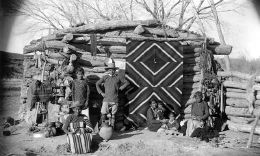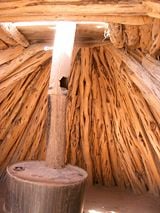Hogan
A hogan (pronounced /hoʊˈgɑːn/, from Navajo hooghan, IPA: [hoːɣan]) is the primary traditional home of the Navajo people. Other traditional structures include the summer shelter, the underground home, and the sweat house. It is usually round and cone shaped, but now they make them square, with the door facing the east to welcome the rising sun for good wealth and fortune.
The hogan is considered sacred to those who practice the Navajo religion. The religious song "The Blessingway" describes the first hogan as being built by Coyote with help from beavers to be a house for First Man, First Woman, and Talking God. The Beaver People gave Coyote logs and instructions on how to build the first hogan, now known as a "forked stick" or "male" (áłchʼįʼ adeezʼá) hogan. The hogan resembles a pyramid with five triangular faces. Earth may fill the spaces between the framework logs, hiding the five faceted shape and creating thick, winter-protective walls. The "forked stick" or "male" Hogan contains a vestibule in the front and was used only for sacred or private ceremonies.
The "circular" or "female" Hogan (tsé bee hooghan), the family home for the Diné people, is much larger and does not contain a vestibule. In it, the children play, the women cook, weave, talk, and entertain and men tell jokes and stories. Navajos made their hogans in this fashion until the 1900s, when they started to make them in hexagonal and octagonal shapes. The change in shape may have been due to the arrival of the railroad. A supply of wooden cross-ties, which could be laid horizontally to form walls of a larger, taller home, allowed the retention of the "female" hogan shape but with more interior room. The doorways of the hogans always face east.
Many cultural taboos are associated with the hogan and its use. Should a death occur in the structure, the body is either buried in the hogan with the entry sealed to warn others away, or the deceased is extracted through a hole knocked in the north side of the structure and it is abandoned and often burned. A hogan may also become taboo for further use if lightning strikes near the structure or a bear rubs against it. Wood from such structures is never reused for any other purpose by a Navajo.
Today, while some older hogans are still used as dwellings and others are maintained for ceremonial purposes, new hogans are rarely intended as family dwellings.
'Hogan' in different languages
These terms are possible Native American sources of the current term hogan:
- hooghan in Navajo
- gowąh in Western Apache
- guughą or kuughą in Chiricahua
See also
External links
Credits
New World Encyclopedia writers and editors rewrote and completed the Wikipedia article in accordance with New World Encyclopedia standards. This article abides by terms of the Creative Commons CC-by-sa 3.0 License (CC-by-sa), which may be used and disseminated with proper attribution. Credit is due under the terms of this license that can reference both the New World Encyclopedia contributors and the selfless volunteer contributors of the Wikimedia Foundation. To cite this article click here for a list of acceptable citing formats.The history of earlier contributions by wikipedians is accessible to researchers here:
The history of this article since it was imported to New World Encyclopedia:
Note: Some restrictions may apply to use of individual images which are separately licensed.


